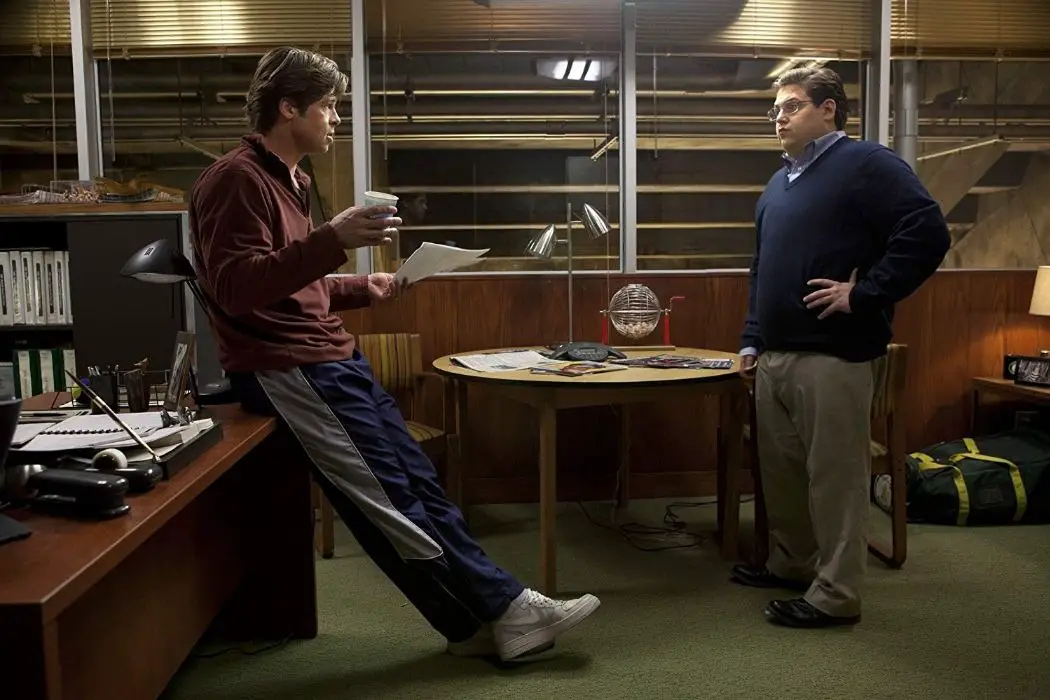Sporting Talk: The Conversations Of MONEYBALL

If favourite films tell you all you need to know…
The world of encapsulating cinema exists within an ever-expanding genre orbit, revolving around the adventures of menacing pirates, double-crossing secret agents, frightful ghouls, and every manner of costumed protagonist in between, most notably in this case: a boardroom of experienced sports stars.
When it comes to tales of overwhelming sporting achievement, the big screen is no stranger to a monumental Grand Prix or two, often finding the (rarely fictitious) pocket of filmmaking a welcome foundation for heroism, humanity, and idle depictions of dramatised hope, all packed with characteristics tasked with managing their quality.
Aesthetics, Dialogue, And Everything In Between
Throughout these depictions of sporting heroes, a number of aspects consistently seem to lend themselves to the overall quality of a sporting picture, regardless of the specific sport at hand or characters the story needs to pivot on. A combination of a somewhat indie aesthetic and impeccably dramatised versions of human dialect blend into a purposefully expanded version of non-fictitious humanity.
By forcing the drama of the seemingly impossible through a lens of grounded aesthetic, the otherwise unimaginable can become completely plausible, a backbone on which the sporting sub-genre of cinema seriously leans on. Between the grain of the optics and the use of dated real world footage, the captured achievements of the sporting greats turn from the stuff of legends to goals within the reach of mere mortals, not a simple task by any means.
However, aesthetics alone can’t drive these tales of sheer success. The unsung hero of the sporting genre exists in the form of conversation, as a whirling weapon of humanised dialect in amongst a mix of what seems like impending stakes really helps to plant the perplexing in a state of realism.
As a deeper dive is taken into this world of sporting cinema, it becomes obvious as to just how much of a recurring character this pulsating dialect truly is, winding its way through countless scenes that find themselves in serious need of grounding, and when it comes to grounding, no film finds its outstanding events in need of a serious bringing back to earth quite like 2011’s baseball flick, Moneyball.
Talking Baseball
Moneyball tells the early 2000’s section of the Oakland A’s sporting story, a period of time that saw general manager Billy Beane, played by Brad Pitt, tasked with amassing a combination of baseball players that all exist within a limited budget, yet capable of championship glory. Easy, right?

Whilst the story of Moneyball does indeed revolve around baseball and all its traditional authentications, the real driving force of the plot, and it’s inhabiting characters motivations, reflect off of the somewhat foggy glasses of sporting finance, an engine that sees Jonah Hill’s character of Peter Brand enter the fold.
Hill’s character of Brand steers the film in its destined direction, pulling in the idea of statistics and the realism involved in the core of the story, finance. With Moneyball venturing down its path of logistics, the highly humanised character of Beane sees that the otherworldly story the Oakland A’s are telling remains grounded, interesting, and full of deserved suspense.
More Than Finance
As Moneyball takes the usual sporting steps towards a story of championship greatness, it wastes no time in planting its feet in the required aesthetics of a non-fictitious picture. With a muted colour scheme and a lens set to establish the years at hand, the film doesn’t waste anytime fantasising a story in need of no extra wonder.
These aesthetics, subtle tones and little dramatised lighting quickly allow for the story to exist within a world of realism, something completely necessary if audiences are to feel included in the plot, an aspect of the sports genre capable of bringing the most incredible of incidents down to a realistic plateau.
Whilst the visuals of Moneyball do indeed muster a certain level of human character, it’s the dialect at hand that serves as a constant reminder of the films grounding. Featuring often stoic levels of dialogue, conversations revolving around finance, ability, and the hardships of a sporting career, the films lingual aesthetics are best observed in the stories moments of decision making; the boardroom scenes.
The Difficulties Of A Meeting Room
Along with the films first real insight into the decision making process of the Oakland A’s, comes an indication into the teams financial stumbling blocks, a combination of clashing ideals and immovable objects, colliding in some seriously humanised meeting room scenes.
Now, of course by their very nature, these depictions of real word events are already at their core somewhat grounded, but Moneyball seems to find solace in these scenes of crunching opinions. As Beane finds himself surrounded by well respected veterans of the team, a wonderful exchange of grounded conversation ensues, forcing differing ideals against each other in a literal setting capsule, meaning that these transferring spells of dialect have a ricocheting quality hard to find in other genres.

By posing separate ideas against each other, the film tends to shine a fresh light of realism on the set, allowing the characters to feel malleable yet coherent with the already presented ideas, allowing these meeting room scenes to function as sporting arenas for the headstrong gladiators of the Oakland A’s.
With a set pivoting on a boardroom table, and characters constantly spouting differing perspectives, Moneyball shares its logical foothold with a film well known for its adverse conversations and environmental confinement, a film responsible for unruly levels of conflicting linguistics that really needs to be mentioned in this analysis; 12 Angry Men.
12 Angry Men might just be the benchmark for all cinematic conversations, with a plot intrinsically hampered to one location and a select few cast members, there’s little else to do but talk, a weapon used incredibly wisely in this case. As a courtroom jury ponder the fate of a man on trial, opinions seem somewhat conclusive, with the exception of one voice, a voice that guides not only the direction of the plot, but the resounding opinion of the wavering audience.
With the jury’s opinion beginning to shift and a complete u turn on the cards, 12 Angry Men concludes with a display of opinionated prowess, proving that a gripping usage of dialogue is all the fuel needed for a dramatic directing of tension.
A Jury Full Of Character
The idea of opinion influencing is without a doubt this films main motif, as escorting the subjective mindsets of the jury and its real world audience becomes 12 Angry Men’s one and only goal in its limited habitat of law very quickly, acting as a theatrical demonstration of loquacious power.
With 12 Angry Men being naturally visually dated in 2019, first hitting screens in 1957, the aesthetics necessary for this modern day analysis are already in play, but even so, the setting of the dramatised jury and their exchanging of words means that not only does the dialect ring true, but we as an audience feel included in the decision making.
It’s this inclusion in the decision making that plants the story, by including the audience in the conversation and its developments, shifting our opinion and its own characters simultaneously, every aspect of the film feels relevant, diegetic, and resolute.
The qualities on show in 12 Angry Men are still ones of real value today, the forceful opinions displayed in thoughtful conversation, the differing characters, the grounded setting, all needed in excess today. Now, back to baseball.
Even More Chit Chat
As Moneyball progress’ down its path of financial problem solving, it’ s Jonah Hill’s character of Peter Brand that turns the tide, bringing a new idea to the forefront of the story, statistics.
Whilst veterans of the team continue to voice their trusted opinions concerning transfers, the fresh face of Hill and his accompanying logistics act as conversational powerhouse, forcing the individual characters of the boardroom to shine through the chatter, all remaining appropriately humanised in the battling dialogue.
The pairing of Beane’s attitude and Brand’s logic serve as such a dialect twister, changing the dynamics of the boardroom dramatically whilst pushing the personalities of the room into the limelight. As tempers rise and objections begin to feel more common, the addition of Hill’s character proves to be the force the conversation needs, creating an incredibly interesting set of relationships within the room for the audience to respond to.
With this second boardroom scene drawing to a close, the differing ideologies of characters forced to share a table really sets the scene for the remaining plot points of Moneyball, using scenes based on pure opinion as a driving force for motivation and character development.
It’s All About Conversing
Complex conversations, subtle humanised aesthetics, and characters shining through moments of opposing ideas, Moneyball spends much of its run-time deep in opinion, something it does with a shining glow and purposeful execution.

An aspect of the baseball flick destined for recognition is its voice, the conversing featured in Moneyball is really what pushes the film towards its achieved qualities, grounding plot points and developing characters, all whilst delivering some seriously entertaining moments of story. Whilst a parallel between Moneyball and 12 Angry Men can be drawn in moments of raging opinions, the story of the Oakland A’s mainly reflects the power of character development shown in the jury service of the older film, crafting the leading roles of Beane and Brand mid conversation, an incredibly entertaining way to shape character and story.
These moments of chit chat, blended with the subtle fire power of a muted aesthetic, force Moneyball to carry a real authenticity, a realism not necessarily always attached to stories of real world wonder, yet the authenticity feels true, an absolute filmmaking achievement.
The Power Of Dialect
Moneyball is a film about finance, a film concerned with the moving of money and its worth, but that isn’t the subject on show here, the real star is conversation, more importantly the power it has on screen. Developing characters, building and ending relationships, the dialect runs the story of this baseball team destined for greatness, and that power can’t be under appreciated.
Baseball might be a team sport, but Moneyball runs by the rules of differing opinions and their collisions, a fuel that ensures the film never feels far from realism and its human foundations.
With the accompaniment of such a subtle aesthetic, and characters being developed at a mile a minute, Moneyball exists in rich conversation, begging the question: is the power of dialect as important in films focused rather on fictitious events? Let us know what you think!
Watch Moneyball
Does content like this matter to you?
Become a Member and support film journalism. Unlock access to all of Film Inquiry`s great articles. Join a community of like-minded readers who are passionate about cinema - get access to our private members Network, give back to independent filmmakers, and more.
If favourite films tell you all you need to know of a person, then let Gremlins, Dumb and Dumber and 500 Days Of Summer inform your decision's infinitely.













